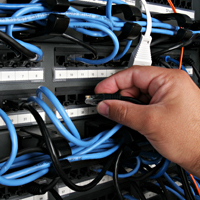
-Graphically visualize all the components, such as servers, routers, etc., which participate in presenting data to the end-user's application.
-Determine the network capacity requirements of your application in order to assure that your network infrastructure can not only support its current requirements, but that it will also be able to scale as your business grows.
-Analyze existing network traffic in order to identify computers that are infected with viruses and/or are exhibiting anomalous behavior, such as large data transfers or denial of service (DOS) attacks.
-Provide insight into how an application will perform in various network environments, such as WANs, and across geographically distributed end-users. Bandwidth and network latency can be analyzed in order to identify the affects on end-user response time, as well as to identify the minimal acceptable configurations to support your application Service Level Agreements (SLA).
-Characterize transaction attributes, such as the amount of frames transferred or the number of client initiated requests, and pinpoint the source of poor end-user response time by identifying the amount of time spent processing on your client, one or more servers and the network.
-Leverage data gathered by network management tools to diagnose ongoing or historical performance and stability problems.
•For more information on network testing and equipment rental service, please contact us.

Network testing